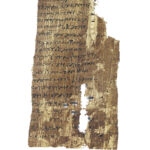| Artefact ID | 494 |
| TM ID | TM 59353 |
| Findspot (DEChriM ID) | - () | Class | Textual |
| Material | Papyrus |
| Writing medium | Codex |
| Text content | Literary |
| Language | Greek |
| Description | PSI VII 757; KV4 Papyrus fragment (6.3 x 11.1 cm) containing the Letter of Barnabas 9.1-6. This is the earliest textual witness to Barnabas' letter, besides Codex Sinaiticus. The text is written in one column, and contextually the verso precedes the recto. Each column consists of approx. 21 lines, 42 lines survive altogether. The ed. pr. does not offer any characteristics of the hand: The script could be described as a flowing, semi-uncial hand containing several ligatures, giving it a slightly documentary appearance; see Kraft 1967: 153. Naldini compares the hand to the script of Codex Sinaiticus; see Naldini 1965: 23. Besides its rudimentary punctuation (high points and enlarged first letter of the following word), the text contains some idiosyncratic nomina sacra: Words such as θεός and κύριος have been abbreviated as their first letter with a dot (with no further indication of the oblique forms). The more common supralinear stroke is found only in l. 8 (verso) above a "κ" (for κύριος "Lord"). The text also contains two instances of accentuation (l. 36 "ὑμῶν" and 38 "παλὶν"). A word-internal staurogram appears in σκληρυνειτε (for the first rho) in l. 16-17 of the recto. There is an emphatic sense break in l. 17-18 on the recto: The beginning of l. 18 has been marked by a horizontal stroke, and in l. 17 a delta with a supralinear line appears in the left margin. It is not clear whether this is an alphabetical numeral or an abbreviation of sorts. This marker is followed by an ekthesis of πάντα in l. 18. The fragment compares closely to the manuscript-family MS G. |
| Selection criteria | Literary genre (Theological), Christian symbols/gestures/isopsephy, Nomina sacra |
| Date from | 300 |
| Date to | 450 |
| Dating criteria | Palaeography. The ed. pr. places the fragment in the late 4th c. (and extends the possibility to the early 5th), which is confirmed by F. Ronconi; see Crisci 2002: no. 152. An earliest date (3rd c.) was given by Roberts; see Kraft 1971: 53. |
| Absolute/relative date | Relative date |
| Archaeological context | Provenance is unknown. |
| Accession number | Florence, Biblioteca Medicea Laurenziana, inv. 18686 |


 Json data
Json data





